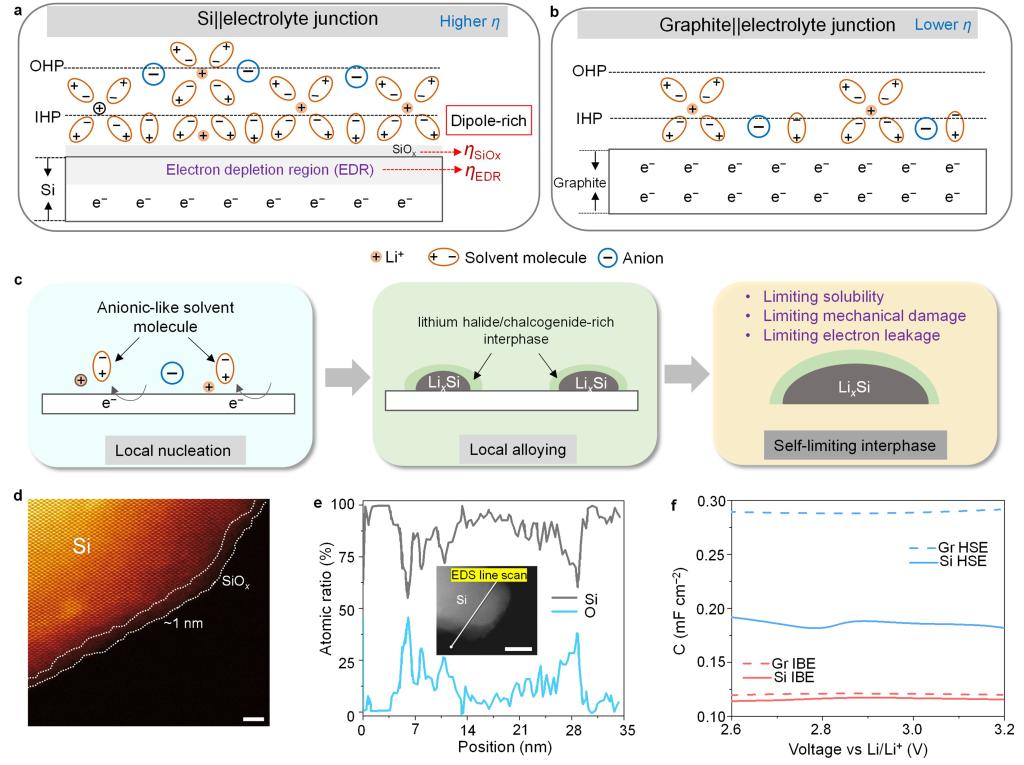Background
There is a significant demand for high-energy lithium-ion batteries (LIBs) with long cycle life, especially for electric vehicles. To achieve cell-level energy densities surpassing 400 Wh kg⁻¹, the ideal strategy is to pair high-voltage Ni-rich (NMC811) cathodes with silicon-majority-graphite (SmG, >1500 mAh g−1) anodes. Silicon offers a theoretical capacity far exceeding graphite, but it suffers from a critical flaw: massive volume expansion (~400%) during operation. This leads to structural degradation, electrode cracking, and a perpetually unstable solid-electrolyte interphase (SEI). These issues cause continuous lithium depletion and rapid capacity fading, particularly under the aggressive chemistry of 4.5V-class high-voltage operation. Therefore, designing a stable electrolyte and interphase that can withstand this coupled chemomechanical degradation is the central bottleneck.
Introduction

Recently, Prof. Weijiang Xue’s research group at the Center for Advancing Materials Performance from the Nanoscale (CAMP-Nano), State Key Laboratory for Mechanical Behavior of Materials, Xi’an Jiaotong University, introduced a hybrid-sulfonamide electrolyte (HSE) to address these issues. By leveraging the unique semiconductor physics of the silicon anode, the HSE—composed of 1 M LiFSI in a dimethylsulfamyl fluoride (DMSF) and N, N-dimethyltrifluoromethanesulfonamide (DM) solvent mixture — programs a self-limiting inorganic interphase on the Si surface. This thin, dense, and mechanically robust layer (enriched with LiF/Li2O/Li2S) is electronically insulating yet Li⁺-permeable, which suppresses further electrolyte decomposition and resists stress from Si expansion, thus "self-limiting" its own growth.
Compared to a industrial carbonate-based electrolyte (IBE) with multiple additives, the HSE-based cells showed breakthrough performance. NMC811||SmG coin cells with the HSE retained 80% capacity after 500 cycles at a high 4.5 V cut-off voltage, whereas the IBE cell failed rapidly. The HSE also enabled operation over a wide temperature range from −40 °C to 60 °C, retaining 61% capacity at −40 °C, a temperature at which the IBE cell delivered almost no capacity. Impressively, 1.4 Ah pouch cells with the HSE achieved an outstandingly long cycle life, retaining 80.0% of initial capacity after 1150 cycles. The HSE also demonstrated exceptional safety, resisting ignition in combustion test and showed no thermal runaway up to 300 °C in accelerated rate calorimetry tests. This work establishes the formation of a self-limiting interphase as a practical electrolyte design strategy for future high-energy, long-lived, and wide-temperature LIBs.
The above research was published on Advanced Materials entitled “4.5-V-class safe lithium-ion batteries with silicon-majority-graphite anodes enabled by self-limiting interphase” (https://advanced.onlinelibrary.wiley.com/doi/10.1002/adma.202515562). Notably, the first author of the paper is Longji Xu, who is a first-year doctoral student who has just started his program. Prof. Weijiang Xue at Center for Advancing Materials Performance from the Nanoscale (CAMP-Nano), State Key Laboratory for Mechanical Behavior of Materials at Xi’an Jiaotong University are the only primary corresponding author and institutions. Other co-authors include Doctor Han Xue and Prof. Li Yao from the State Key Laboratory of Metal Matrix Composites at Shanghai Jiao Tong University, Prof. Jaekyung Sung from the department of Materials Engineering and Convergence Technology, Gyeongsang National University, Ph.D. student Wang Jianqiang and Prof. Gao Rui from the School of Energy and Power Engineering, Xi’an Jiaotong University and Dr. Han Qiao from Dalian Institute of Chemical Physics, Chinese Academy of Sciences. This work was also supported by the CAMP-Nano and the Analysis and Testing Center at Xi’an Jiaotong University.


